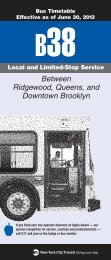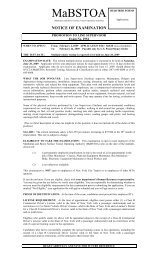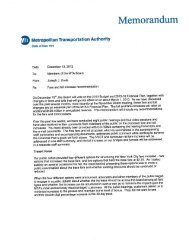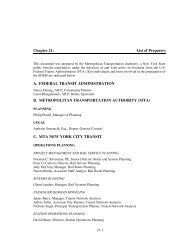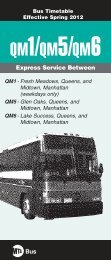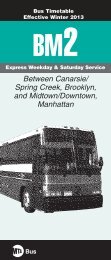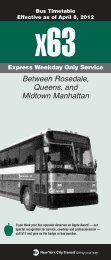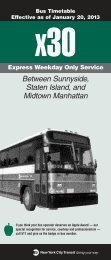Greening Mass Transit & Metro Regions: The Final Report - MTA
Greening Mass Transit & Metro Regions: The Final Report - MTA
Greening Mass Transit & Metro Regions: The Final Report - MTA
Create successful ePaper yourself
Turn your PDF publications into a flip-book with our unique Google optimized e-Paper software.
Water Management<br />
Water resources management, conservation, and protection<br />
"As one of the world's leading<br />
transportation authorities and one of New<br />
York City's major water users, the <strong>MTA</strong> is<br />
uniquely positioned to set a global standard<br />
for innovative water resource management.<br />
By significantly reducing its use of potable<br />
water, guarding against future flooding risks,<br />
and making beneficial use of ground and<br />
storm water to run its operations, the <strong>MTA</strong><br />
can become a sustainability leader while<br />
addressing the challenges of a warming<br />
climate and saving the authority and its<br />
customers money."<br />
– Alex Matthiessen, Hudson Riverkeeper<br />
and president, Riverkeeper<br />
Chair, Water Management Group<br />
While the public is unlikely to associate the <strong>MTA</strong> with water<br />
issues, water management plays a distinct role in the<br />
authority’s sustainability efforts. Given the scale of its<br />
operations, the <strong>MTA</strong> is a major consumer of the metropolitan<br />
area’s potable water. Its daily operations also include pumping<br />
out groundwater to keep its track and tunnels dry. In addition,<br />
many <strong>MTA</strong> properties and rights-of-way border wetlands and<br />
waterways that serve vital ecological functions and that<br />
should be protected. <strong>The</strong> <strong>MTA</strong> must also manage wastewater<br />
and runoff from its properties and operations during intense<br />
storms, when flooding can both disrupt service and endanger<br />
local water quality by overwhelming sewer systems.<br />
At present, <strong>MTA</strong> operations are estimated to use roughly<br />
2.6 billion gallons of potable water per year, of which a large<br />
share, estimated between 1.2 and 1.4 billion gallons, is used<br />
in the flow process to cool NYCT subway system transformers.<br />
Washing vehicles also accounts for a significant share<br />
of the <strong>MTA</strong>’s overall water use. <strong>The</strong> Commission looked at<br />
ways to reduce the <strong>MTA</strong>’s potable water consumption,<br />
including expanded use of greywater and rainwater for<br />
nonpotable needs such as washing vehicles. A preliminary<br />
study undertaken by the Commission indicates that, in<br />
addition to incremental conservation measures, there are<br />
Left: A rainwater collection system on the roof of the Corona Maintenance Shop<br />
in Queens drains rainwater into a 40,000-gallon underground storage tank that<br />
supplies water to a subway car washer.<br />
a number of plausible options for significant reduction in<br />
the <strong>MTA</strong>’s use of potable water. Depending on which mix<br />
of programs and technologies proves feasible, the <strong>MTA</strong><br />
should be able to reduce its use of potable water by up<br />
to 75 percent by 2020.<br />
Research conducted by the Commission concluded that<br />
many transportation agencies place a relatively low emphasis<br />
on water-reduction targets. By significantly reducing its<br />
water consumption, the <strong>MTA</strong> would be viewed as an<br />
industry leader in sustainability. Globally, water is increasingly<br />
understood as a precious but diminishing resource,<br />
vital for life and economic prosperity.<br />
An important first step will be to implement consistent,<br />
systemwide water-metering and submetering at <strong>MTA</strong> facilities,<br />
which the Commission has cited as a top priority in its<br />
Interim <strong>Report</strong>. Conservation measures would then include a<br />
range of strategies, from staggered vehicle wash schedules<br />
to harvested rainwater and water-saving fixtures in public<br />
stations. Water management also plays a large role in facilities<br />
design. Among the green features of the <strong>MTA</strong>’s LEEDcertified<br />
Corona Maintenance Facility is a 40,000-gallon<br />
rainwater capture system to supply water for washing<br />
subway cars. Several other <strong>MTA</strong> facilities operate vehicle<br />
wash systems using recycled greywater to reduce strain<br />
on potable water systems, while water-control innovations<br />
such as green roofs are part of the design of <strong>MTA</strong> facilities.<br />
One of the more intriguing water management ideas involves<br />
the use of groundwater. <strong>The</strong> <strong>MTA</strong> currently pumps some<br />
8 million gallons of groundwater per day out of its subway<br />
tunnels on a dry day and up to 13 million gallons per day<br />
during storms. Once regarded as a nuisance, groundwater<br />
has a number of potential uses. From a global perspective,<br />
this water should be seen as a valuable resource latent in<br />
<strong>MTA</strong> properties. Possible uses include thermal exchange<br />
heating and cooling in <strong>MTA</strong> facilities or nearby buildings.<br />
<strong>The</strong> Commission is currently identifying potential uses near<br />
current groundwater pump sites.<br />
51



